ECU JEEP WRANGLER 2013 JK / 3.G Owner's Manual
[x] Cancel search | Manufacturer: JEEP, Model Year: 2013, Model line: WRANGLER, Model: JEEP WRANGLER 2013 JK / 3.GPages: 132, PDF Size: 3.32 MB
Page 101 of 132
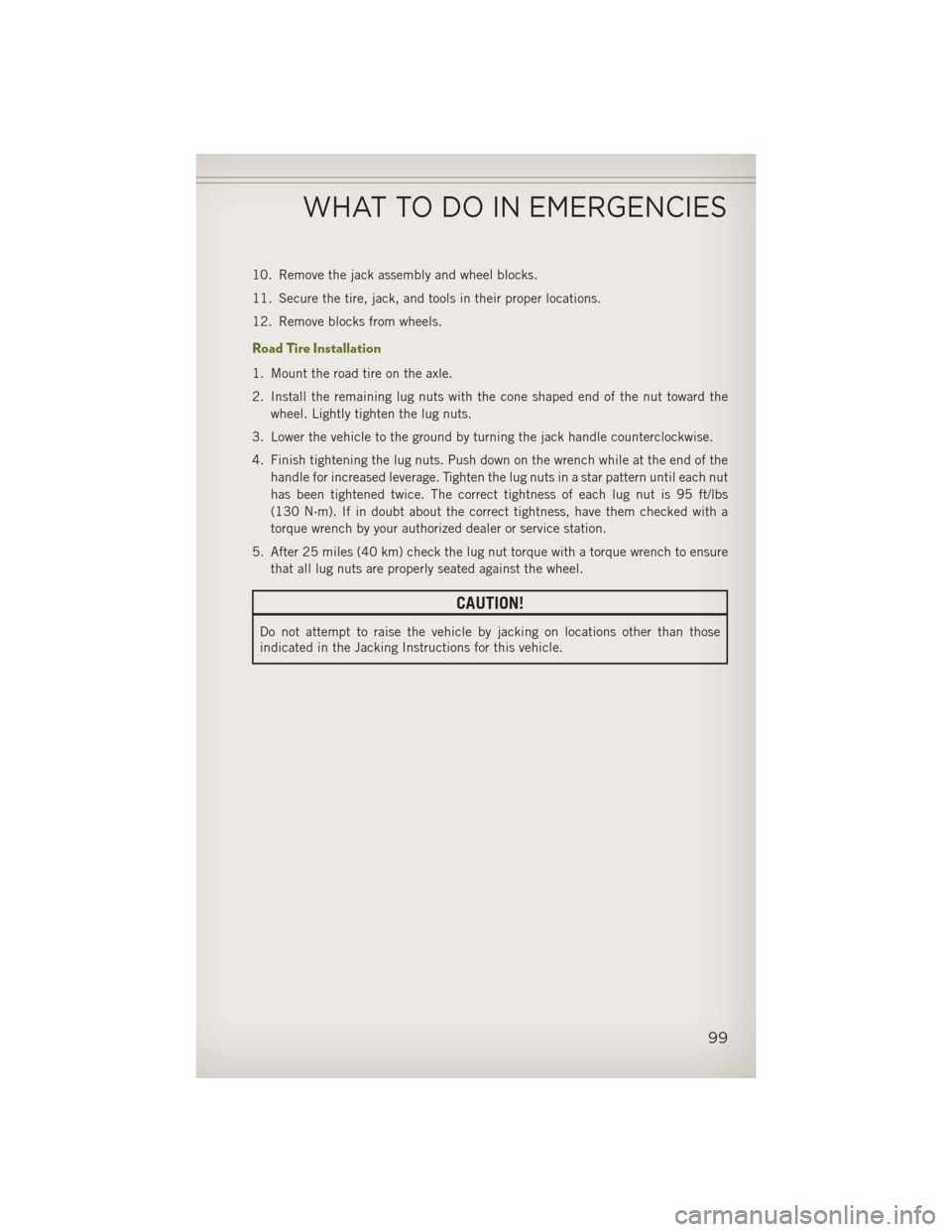
10. Remove the jack assembly and wheel blocks.
11. Secure the tire, jack, and tools in their proper locations.
12. Remove blocks from wheels.
Road Tire Installation
1. Mount the road tire on the axle.
2. Install the remaining lug nuts with the cone shaped end of the nut toward thewheel. Lightly tighten the lug nuts.
3. Lower the vehicle to the ground by turning the jack handle counterclockwise.
4. Finish tightening the lug nuts. Push down on the wrench while at the end of the handle for increased leverage. Tighten the lug nuts in a star pattern until each nut
has been tightened twice. The correct tightness of each lug nut is 95 ft/lbs
(130 N·m). If in doubt about the correct tightness, have them checked with a
torque wrench by your authorized dealer or service station.
5. After 25 miles (40 km) check the lug nut torque with a torque wrench to ensure that all lug nuts are properly seated against the wheel.
CAUTION!
Do not attempt to raise the vehicle by jacking on locations other than those
indicated in the Jacking Instructions for this vehicle.
WHAT TO DO IN EMERGENCIES
99
Page 102 of 132
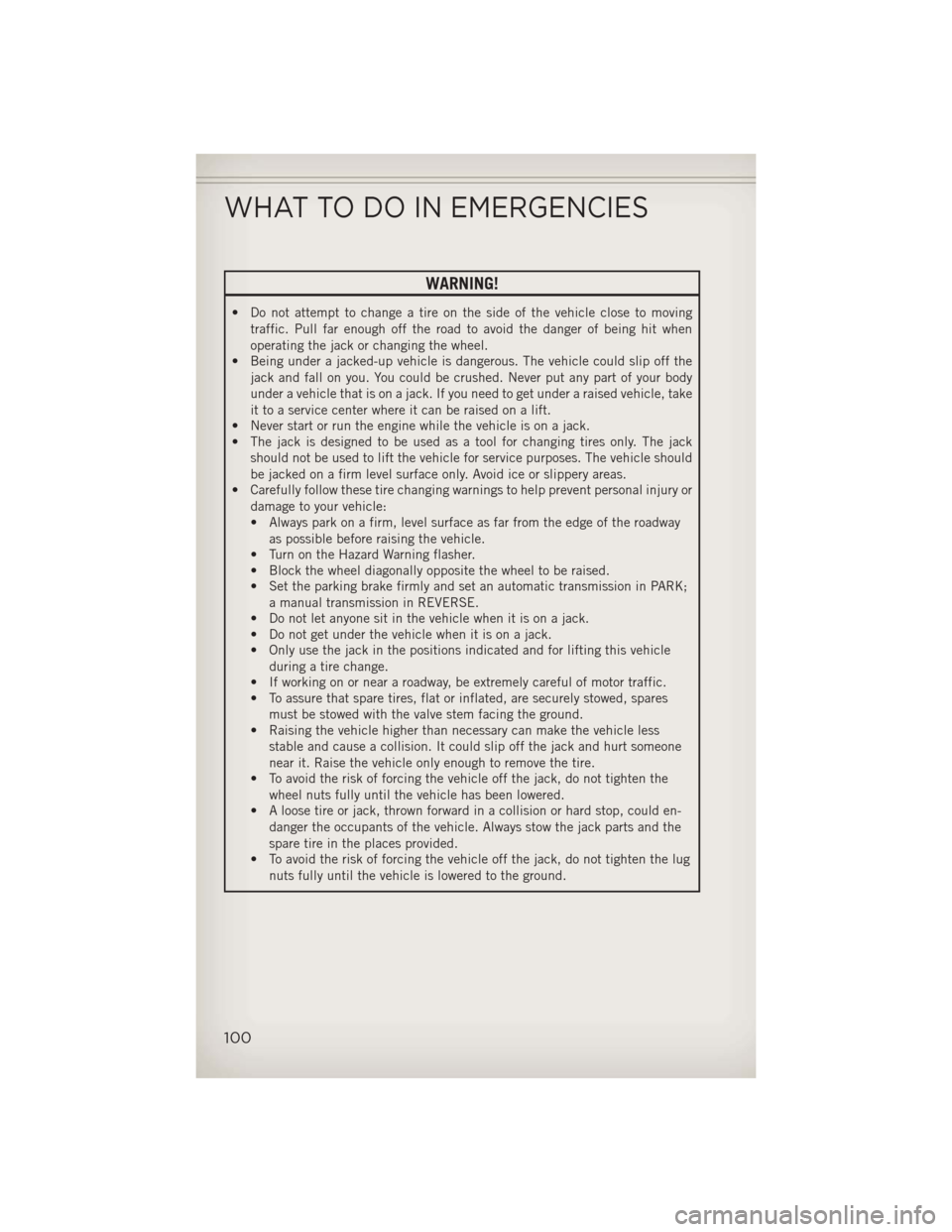
WARNING!
• Do not attempt to change a tire on the side of the vehicle close to movingtraffic. Pull far enough off the road to avoid the danger of being hit when
operating the jack or changing the wheel.
• Being under a jacked-up vehicle is dangerous. The vehicle could slip off the
jack and fall on you. You could be crushed. Never put any part of your body
under a vehicle that is on a jack. If you need to get under a raised vehicle, take
it to a service center where it can be raised on a lift.
• Never start or run the engine while the vehicle is on a jack.
• The jack is designed to be used as a tool for changing tires only. The jack
should not be used to lift the vehicle for service purposes. The vehicle should
be jacked on a firm level surface only. Avoid ice or slippery areas.
• Carefully follow these tire changing warnings to help prevent personal injury or
damage to your vehicle:
• Always park on a firm, level surface as far from the edge of the roadwayas possible before raising the vehicle.
• Turn on the Hazard Warning flasher.
• Block the wheel diagonally opposite the wheel to be raised.
• Set the parking brake firmly and set an automatic transmission in PARK;
a manual transmission in REVERSE.
• Do not let anyone sit in the vehicle when it is on a jack.
• Do not get under the vehicle when it is on a jack.
• Only use the jack in the positions indicated and for lifting this vehicle
during a tire change.
• If working on or near a roadway, be extremely careful of motor traffic.
• To assure that spare tires, flat or inflated, are securely stowed, spares
must be stowed with the valve stem facing the ground.
• Raising the vehicle higher than necessary can make the vehicle less
stable and cause a collision. It could slip off the jack and hurt someone
near it. Raise the vehicle only enough to remove the tire.
• To avoid the risk of forcing the vehicle off the jack, do not tighten the
wheel nuts fully until the vehicle has been lowered.
• A loose tire or jack, thrown forward in a collision or hard stop, could en-
danger the occupants of the vehicle. Always stow the jack parts and the
spare tire in the places provided.
• To avoid the risk of forcing the vehicle off the jack, do not tighten the lug
nuts fully until the vehicle is lowered to the ground.
WHAT TO DO IN EMERGENCIES
100
Page 108 of 132
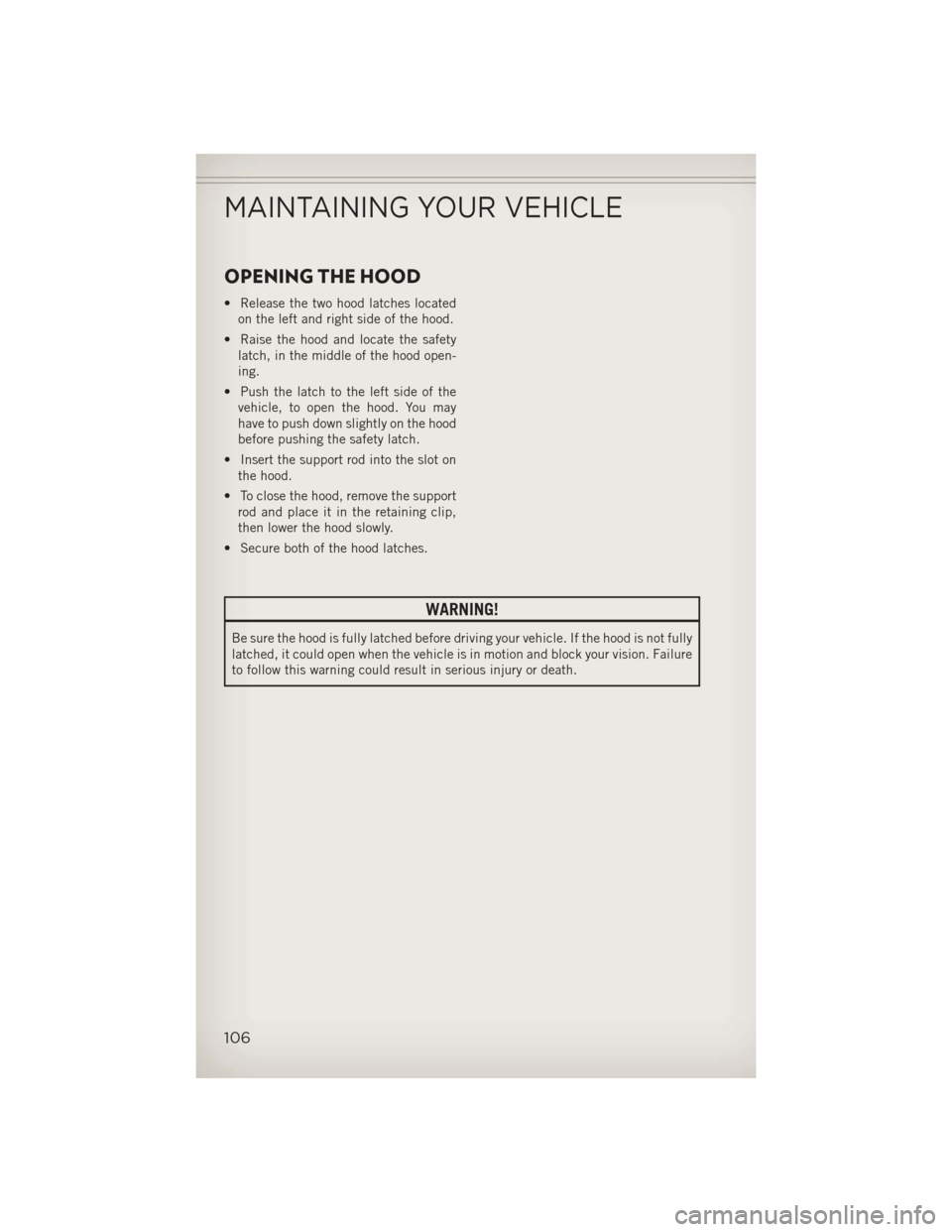
OPENING THE HOOD
• Release the two hood latches locatedon the left and right side of the hood.
• Raise the hood and locate the safety latch, in the middle of the hood open-
ing.
• Push the latch to the left side of the vehicle, to open the hood. You may
have to push down slightly on the hood
before pushing the safety latch.
• Insert the support rod into the slot on the hood.
• To close the hood, remove the support rod and place it in the retaining clip,
then lower the hood slowly.
• Secure both of the hood latches.
WARNING!
Be sure the hood is fully latched before driving your vehicle. If the hood is not fully
latched, it could open when the vehicle is in motion and block your vision. Failure
to follow this warning could result in serious injury or death.
MAINTAINING YOUR VEHICLE
106
Page 124 of 132
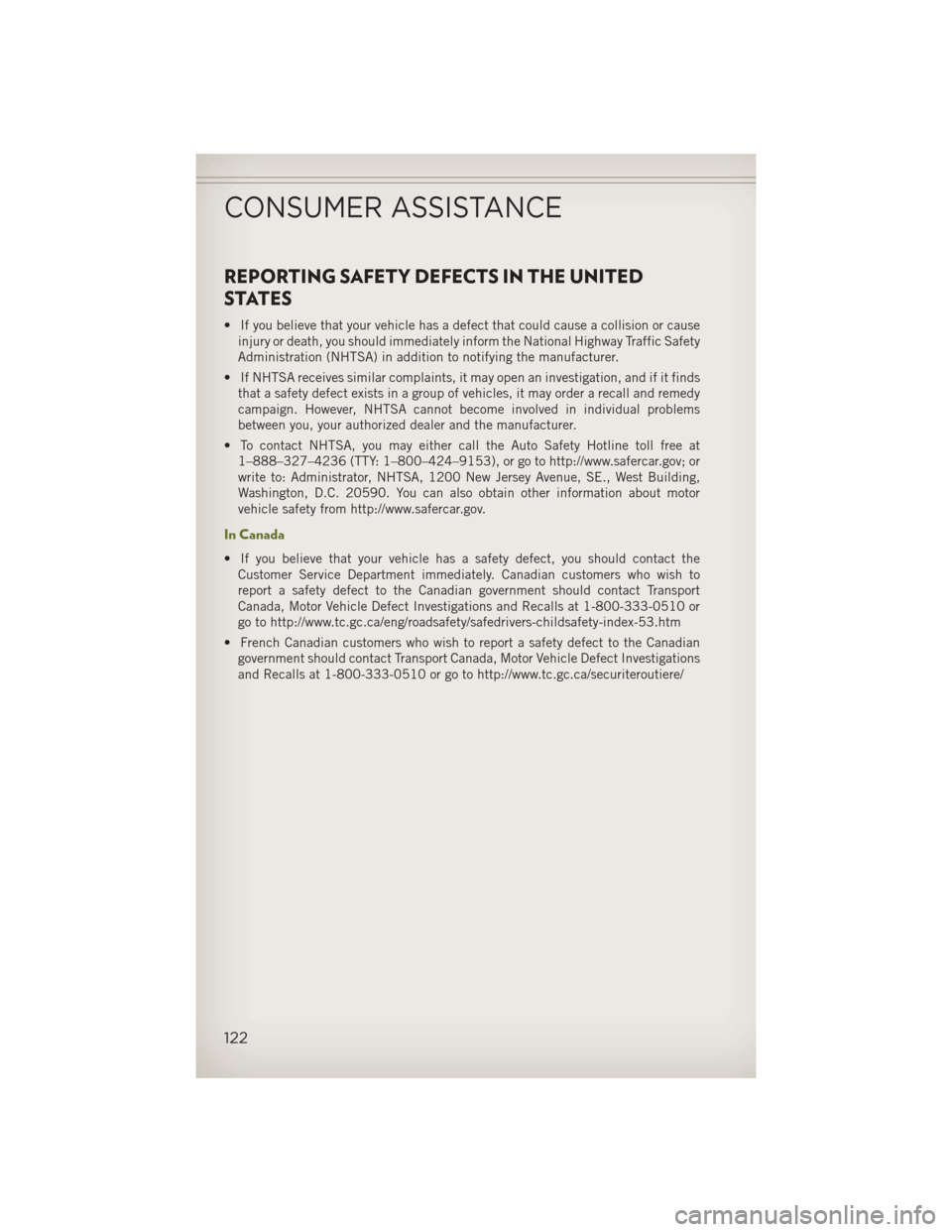
REPORTING SAFETY DEFECTS IN THE UNITED
STATES
• If you believe that your vehicle has a defect that could cause a collision or causeinjury or death, you should immediately inform the National Highway Traffic Safety
Administration (NHTSA) in addition to notifying the manufacturer.
• If NHTSA receives similar complaints, it may open an investigation, and if it finds that a safety defect exists in a group of vehicles, it may order a recall and remedy
campaign. However, NHTSA cannot become involved in individual problems
between you, your authorized dealer and the manufacturer.
• To contact NHTSA, you may either call the Auto Safety Hotline toll free at 1–888–327–4236 (TTY: 1–800–424–9153), or go to http://www.safercar.gov; or
write to: Administrator, NHTSA, 1200 New Jersey Avenue, SE., West Building,
Washington, D.C. 20590. You can also obtain other information about motor
vehicle safety from http://www.safercar.gov.
In Canada
• If you believe that your vehicle has a safety defect, you should contact theCustomer Service Department immediately. Canadian customers who wish to
report a safety defect to the Canadian government should contact Transport
Canada, Motor Vehicle Defect Investigations and Recalls at 1-800-333-0510 or
go to http://www.tc.gc.ca/eng/roadsafety/safedrivers-childsafety-index-53.htm
• French Canadian customers who wish to report a safety defect to the Canadian government should contact Transport Canada, Motor Vehicle Defect Investigations
and Recalls at 1-800-333-0510 or go to http://www.tc.gc.ca/securiteroutiere/
CONSUMER ASSISTANCE
122
Page 126 of 132
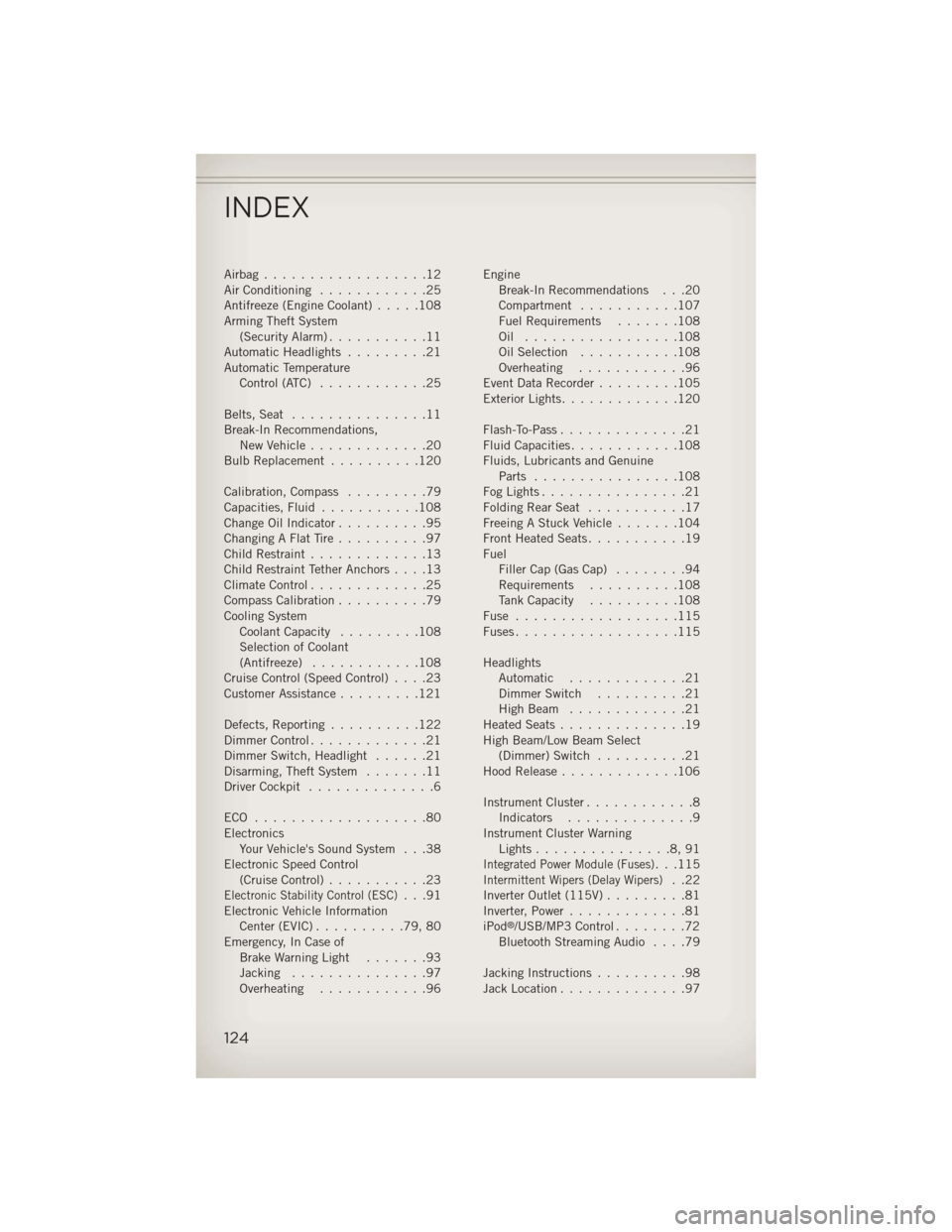
Airbag..................12
Air Conditioning............25
Antifreeze (Engine Coolant) .....108
Arming Theft System (Security Alarm) ...........11
Automatic Headlights .........21
Automatic Temperature Control (ATC) ............25
Belts, Seat ...............11
Break-In Recommendations, New Vehicle .............20
Bulb Replacement ..........120
Calibration, Compass .........79
Capacities, Fluid ...........108
Change Oil Indicator ..........95
Changing A Flat Tire ..........97
Child Restraint .............13
Child Restraint Tether Anchors ....13
ClimateControl.............25
Compass Calibration ..........79
Cooling System Coolant Capacity .........108
Selection of Coolant
(Antifreeze) ............108
Cruise Control (Speed Control) ....23
Customer Assistance .........121
Defects, Reporting ..........122
Dimmer Control .............21
Dimmer Switch, Headlight ......21
Disarming, Theft System .......11
Driver Cockpit ..............6
ECO ...................80
Electronics Your Vehicle's Sound System . . .38
Electronic Speed Control (Cruise Control) ...........23
Electronic Stability Control (ESC)...91
Electronic Vehicle Information Center(EVIC)..........79,80
Emergency, In Case of Brake Warning Light .......93
Jacking ...............97
Overheating ............96 Engine
Break-In Recommendations . . .20
Compartment ...........107
Fuel Requirements .......108
Oil .................108
Oil Selection ...........108
Overheating ............96
Event Data Recorder .........105
Exterior Lights .............120
Flash-To-Pass ..............21
Fluid Capacities ............108
Fluids, Lubricants and Genuine Parts ................108
FogLights................21
FoldingRearSeat ...........17
Freeing A Stuck Vehicle .......104
Front Heated Seats ...........19
Fuel Filler Cap (Gas Cap) ........94
Requirements ..........108
Tank Capacity ..........108
Fuse ..................115
Fuses..................115
Headlights Automatic .............21
Dimmer Switch ..........21
HighBeam .............21
Heated Seats ..............19
High Beam/Low Beam Select (Dimmer) Switch ..........21
Hood Release .............106
Instrument Cluster ............8
Indicators ..............9
Instrument Cluster Warning Lights...............8,91
Integrated Power Module (Fuses)...115Intermittent Wipers (Delay Wipers)..22
Inverter Outlet (115V) .........81
Inverter, Power .............81
iPod
®/USB/MP3 Control ........72
Bluetooth Streaming Audio ....79
Jacking Instructions ..........98
Jack Location ..............97
INDEX
124